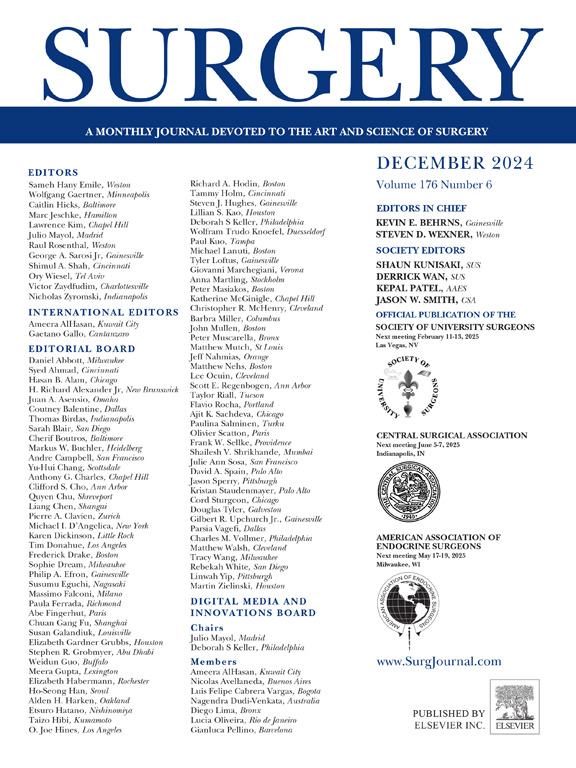医院容积与再手术冠状动脉搭桥术预后的关系
IF 2.7
2区 医学
Q1 SURGERY
引用次数: 0
摘要
再手术冠状动脉搭桥术后的预后尚未得到广泛的研究。评估当代国家队列,我们在患者和医院水平上评估了再手术冠状动脉搭桥手术后的急性临床和经济后遗症。方法查询2016-2021年全国再入院数据库,以确定所有因选择性孤立冠状动脉搭桥手术住院的成人(≥18岁)。有冠状动脉搭桥手术史的患者分为ReOp组(其他为非ReOp组)。最高四分位数的中心被认为是高容量中心。建立多变量回归模型来评估ReOp与临床和财务结果的独立关联。结果470,546例患者中,5.0%被分类为ReOp。ReOp平均年龄较大(70岁[63-76]vs 67岁[60-73]),P <;.001),女性更常见(26.7% vs 21.7%, P <;.001),且Elixhauser合并症指数较高(5 [4 - 7]vs 4 [3-5], P <;措施)。风险调整后,ReOp与院内死亡率相关(校正优势比0.87,95%可信区间0.74-1.03)。然而,ReOp面临更大的感染几率(校正优势比1.72,95%可信区间1.60-1.85)、血栓栓塞(1.85,1.45-2.36)和中风(1.35,1.12-1.64)。ReOp也与更高的成本相关(β +$9,845, 95% CI 8,888-0,802)。在大容量中心,5.1%的冠状动脉旁路移植术受者是ReOp。再手术与较大的主要并发症的调整几率(调整优势比1.19,95%可信区间1.12-1.27)和住院费用增加相关(β +$6,782, 95%可信区间5,725-7,837)。结论再手术冠状动脉搭桥术后面临重大围手术期后果的风险增加,与病例数量无关。需要进一步的研究来为这些患者制定最佳的围手术期护理途径。本文章由计算机程序翻译,如有差异,请以英文原文为准。

Association of hospital volume with outcomes for reoperative coronary artery bypass grafting
Introduction
Outcomes following reoperative coronary artery bypass graft surgery are widely underexplored. Evaluating a contemporary national cohort, we assessed acute clinical and financial sequelae following reoperative coronary artery bypass graft surgery at the patient and hospital levels.
Methods
The 2016–2021 Nationwide Readmissions Database was queried to identify all adult (≥18 years) hospitalizations for elective isolated coronary artery bypass graft surgery. Patients with a history of coronary artery bypass graft surgery were categorized as ReOp (others: Non-ReOp). Centers in the highest quartile were considered high-volume centers. Multivariable regression models were built to assess the independent association of ReOp with clinical and financial outcomes.
Results
Of ∼470,546 patients, 5.0% were classified as ReOp. On average, ReOp was older (70 [63–76] vs 67 years [60–73], P < .001), more often female (26.7 vs 21.7%, P < .001), and of a higher Elixhauser comorbidity index (5 [4–7] vs 4 [3–5], P < .001).
Following risk adjustment, ReOp was linked with comparable likelihood of in-hospital mortality (adjusted odds ratio 0.87, 95% confidence interval 0.74–1.03). However, ReOp faced greater odds of infection (adjusted odds ratio 1.72, 95% confidence interval 1.60–1.85), thromboembolism (1.85, 1.45–2.36), and stroke (1.35, 1.12–1.64). ReOp was also linked with greater costs (β +$9,845, 95% CI 8,888–0,802).
At high-volume centers, 5.1% of coronary artery bypass graft surgery recipients were ReOp. Reoperation was associated with greater adjusted odds of major complications (adjusted odds ratio 1.19, 95% confidence interval 1.12–1.27) and increased hospitalization expenditures (β +$6,782, 95% confidence interval 5,725–7,837).
Conclusion
The increased risk of facing major perioperative outcomes following reoperative coronary artery bypass graft surgery persists at centers despite case volume. Further studies are needed to develop optimal perioperative care pathways for these patients.
求助全文
通过发布文献求助,成功后即可免费获取论文全文。
去求助
来源期刊

Surgery
医学-外科
CiteScore
5.40
自引率
5.30%
发文量
687
审稿时长
64 days
期刊介绍:
For 66 years, Surgery has published practical, authoritative information about procedures, clinical advances, and major trends shaping general surgery. Each issue features original scientific contributions and clinical reports. Peer-reviewed articles cover topics in oncology, trauma, gastrointestinal, vascular, and transplantation surgery. The journal also publishes papers from the meetings of its sponsoring societies, the Society of University Surgeons, the Central Surgical Association, and the American Association of Endocrine Surgeons.
 求助内容:
求助内容: 应助结果提醒方式:
应助结果提醒方式:


